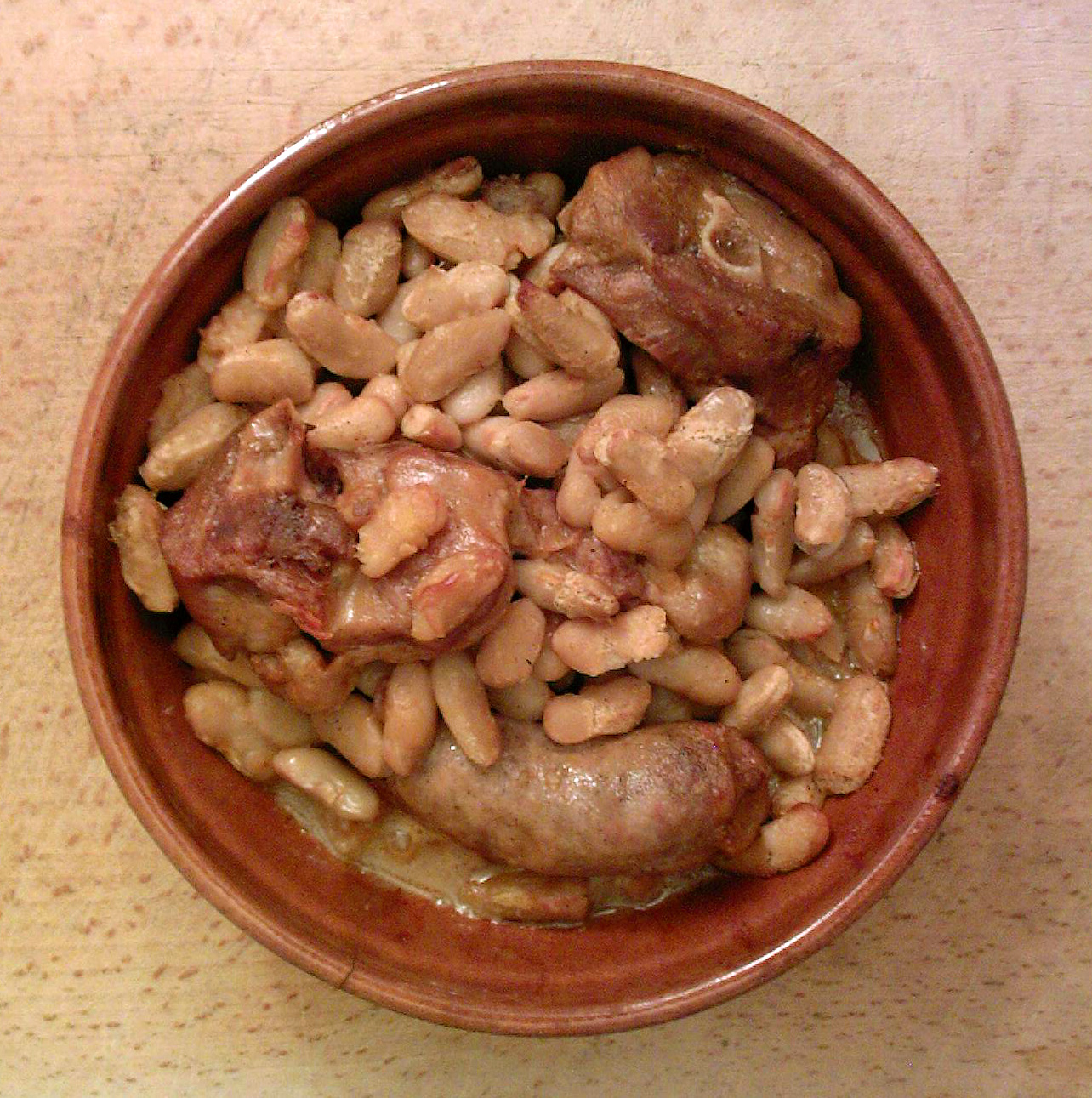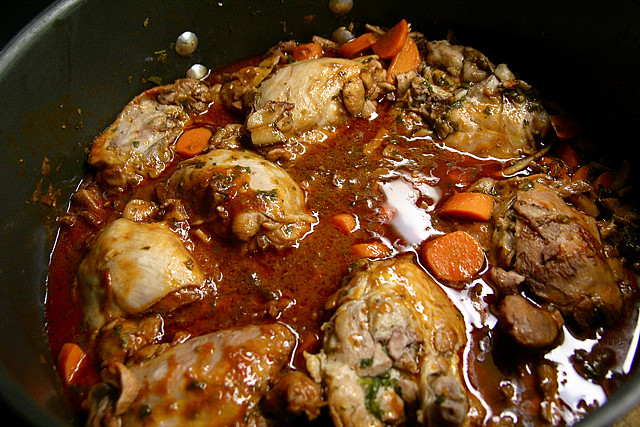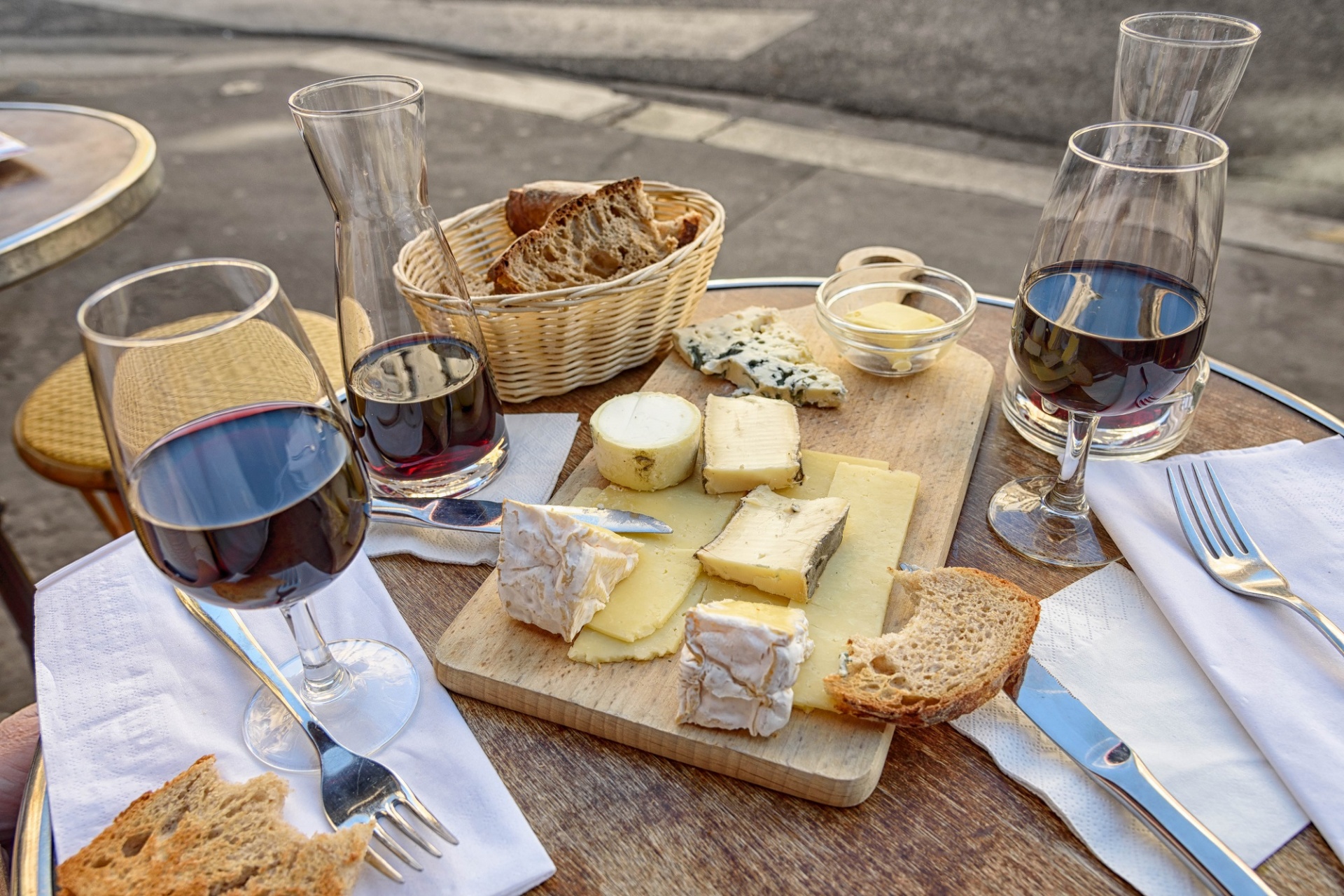
If you were asked about the most delicious cuisine in the world, what countries would come to mind? According to most of the rankings I’ve read, France is often placed second, with Italy as the solid winner.
In 2010, UNESCO paid a gracious tribute to French gastronomy by inscribing it on the Intangible Cultural Heritage of Humanity list. Let’s try to understand why French cuisine is held in such high regard around the world, and what makes it special.
In this article, I will present you with a list of eight French foods you must try, a French cuisine overview, the top words and expressions for talking about food and cooking in French, and much more.
 Table of Contents
Table of Contents
- Must-Try French Dishes
- Unique French Products
- Food Vocabulary
- Frogs and Other Misconceptions
- Le Mot De La Fin
1. Must-Try French Dishes
To begin with, here are the top eight dishes you should definitely try in France or in an authentic French restaurant. Some of these can be cooked just about anywhere with local ingredients but, especially for the cheesy meals, you often need the original imported product to make it taste and feel right.
1 – Tartiflette
Tartiflette is one of the classic French dishes (and a personal favorite of yours truly), originating from mountainous regions such as the northern Alps. It has everything you could dream of: potatoes, fried onions, lardons (sliced bacon), a hint of white wine and garlic, and an unhealthy amount of reblochon, one of the tastiest cheeses ever conceived.
As long as you get the right ingredients, you cannot fail at cooking a Tartiflette. Just put everything but the cheese in a tray, slice a big reblochon in half along the width, and place each part on top of everything else. Put it in the oven until it looks glorious and golden.

Une tartiflette (Photo by David Harris under CC BY 2.0)
2 – Steak Tartare
Do you trust your butcher? Are you convinced their meat is fresh, high-quality, and kept refrigerated at all times? If that’s the case, then it’s time to experience the very best way to enjoy beef: raw.
The meat can either be prepared with a grinder (the lazy and lesser option) or minced with a knife (the flavorful yet tedious option—but good things come at a price, right?). Then, mix it with a bunch of herbs and condiments, a fresh egg yolk, capers, minced shallots, and I promise you the time of your life.

Un steak tartare (Photo by insatiablemunch under CC BY 2.0)
3 – Cassoulet
Cassoulet is a specialty from the Languedoc region based on white beans and slow-cooked meat. The name comes from the traditional cooking pot called cassole where the cassoulet simmers for over seven hours, through a very specific and controlled process.
It’s something that I’d recommend you try in a good French restaurant before you try it at home, because of the wide variety of ingredients and difficult cooking methods involved.
When cooked properly, the duck leg confit is slow-cooked in duck fat which tenderizes the meat until it just melts in your mouth. It’s nothing like chicken—it’s just on a whole different level.

Un cassoulet
4 – Crêpes
Let’s start off with an important disclaimer: Crêpes are NOT pancakes (and vice-versa). The list of ingredients is very similar, but American-style pancakes are thick and fluffy while French crêpes are thin and delicate.
You can eat crêpes with sweet ingredients (jam, chocolate, brown sugar) or savory ingredients (bacon, spinach, mushrooms). We even have a special holiday for crêpes called La chandeleur (originally a Christian celebration that lost its religious meaning for most French people over the years).

Des crêpes
5 – Endives au jambon
Being a specialty from my home region, this recipe has always been close to my heart. It’s based on steam-cooked endives (“endives” or “chicory”) wrapped in cooked ham, bathed in béchamel sauce, and topped with grated cheese.

Des endives au jambon (Photo by Jeremy Keith under CC BY 2.0)
6 – Coq au vin
Are you looking for French cuisine classics with sophisticated ingredients to impress your friends? Look no further.
Coq au vin is a timeless classic: a casserole of chicken legs slowly stewed in red wine with herbs, spices, olive oil, and tons of fancy stuff that make for a rich and deep flavor.

Du coq au vin (Photo by Steven Depolo under CC BY 2.0)
7 – Moule marinières
Often found in the northern regions of France and in Belgium, moules marinières are usually served with fries and simply called moules frites (“mussels and fries”).
The eponymous marinière sauce is made with white wine and shallots (add some cream for a rich and delicious twist). This is a classic dish often found in inexpensive brasseries (simple French restaurants with a cheap lunch menu) in the Hauts-de-France region.
8 – Fondue savoyarde
Take a ton of mountain cheese (typically Comté, Beaufort, or Emmental) and melt it with white wine, garlic, and a bit of kirch. Serve it with bread, charcuterie (cold meat cuts) and more white wine, and there you have it: the most decadent of French specialties!
But how do you eat that? It’s simple enough: stick a piece of bread on a spike and dip it into the cheese right in the cooking bowl. Try not to lose your bread!

La fondue savoyarde (Photo by Camille Gévaudan under CC BY-SA 3.0)
- → Learn more about French dishes with our free vocabulary list on FrenchPod101.com.
2. Unique French Products
Now that I’ve teased you with French recipes, let’s talk about another important aspect of French cuisine that doesn’t involve spending two hours in the kitchen or juggling five pans and long lists of bizarre ingredients.
France is famous for a lot of unique products, many of which feature various region-specific twists: le vin (“wine”), le fromage (“cheese”), le pain (“bread”), and la charcuterie (“cold cuts”).
They all play a big role in the so-called Art de Vivre (“Art of Living”) that we pride ourselves on cultivating. The French sure love their wine, cheese, bread, and charcuterie, especially when all four are combined to make for the happiest apéro (“happy hour”).
1 – “Wine is bottled poetry.”
(Robert Louis Stevenson)
French wine is produced across the entire country in large quantities (around sixty million hectoliters per year, or about eight billion bottles), making France one of the biggest wine producers in the world.
Most wines are made to accompany food and this is where it gets tricky. Even though there are some general rules, such as “red wine is for red meat, white is for white meat and fish,” it’s more complex than that.
With thousands of different bottles of all shapes and colors, the wine department in a French supermarket is intimidating. Truth be told, it takes lots of research or serious oenology classes before you can choose the right bottle at the right moment. But don’t sweat it too much; unless you’re dining with experts, nobody will notice if the pairing isn’t perfect.
With so many styles, grape types, terroirs, and labels, it’s a whole world of rich and interesting flavors begging to be explored. You can sip it, drink it, share it, gift it, or even cook with it. Wine is a pillar of French culture.

Du vin (“Wine”) (Photo by PRA under CC BY-SA 3.0)
2 – “Life is great. Cheese makes it better.”
(Avery Aames)
I’ll do my best not to get too emotional in this section, as cheese is my personal weakness and I could praise it for hours.
There are around 1600 distinct French cheeses, each with a unique shape, texture, aroma, flavor, and other properties. They can be made from various kinds of milk and all have different levels of humidity, fat, and calcium.
French President Charles de Gaulle once said: “How can you govern a country which has two hundred and forty-six varieties of cheese?” Fair enough, but we can simplify it by placing them into only eight categories.
French cheese is not for the faint of heart. They range from the easy-going and fairly mainstream Brie to the robust and divisive Roquefort. But the most intense experience lies with the smelliest and most repulsive-looking pieces of the Plateau de fromages (“Cheese platter”).
Cheeses with a lot of character may not be for everyone but once you fall in love, you’re in for a treat. Nothing can compare to the hypnotizing scent of a Munster, and the rich texture of melted Reblochon will make you reach new heights of foodgasm.

Un plateau de fromages (“A cheese platter”)
3 – “Tout est bon dans le cochon.“
(“Everything is good in a pig.” – French proverb)
Another classic French apéro, often served alongside wine and cheese, is charcuterie.
It covers a wide range of cold cuts, from ham to saucisson (dry-cured sausage), mortadella, smoked ham, cured ham, and much more.
The word charcuterie originally comes from chair cuite (“cooked flesh”). It can be cooked or raw and comes mostly (but not exclusively) from pork, with salt used as a preservation agent. It’s especially popular in southern France and in the mountains, but still widely enjoyed in the rest of the country.
An all-time classic of charcuterie is the saucisson sec: a thick dry-cured sausage eaten cold in thin slices, and best enjoyed with bread, wine, and friends.
4 – Happiness is a Fresh Baguette
We’ve all heard of the iconic French baguette, and as you walk through the streets of any city in France, you’ll realize that there’s truth in the cliché. The French do stroll around with bread under their arm.
Here are the golden rules of baguetiquette:
- You can wipe your plate with it.
Yeah, you can hold it with your fingers and dip it in sauce. It’s fine. (And it makes washing dishes easier. Everybody wins.) - Don’t put it on the plate.
In restaurants, bread is usually served in a basket. In general, you might notice that French people never place bread on their plate but rather next to it on the table. - Cover it with cheese…
…or whatever you like, really. Paté is a prime choice; chocolate spread or crème de marrons (“chestnut paste”) are also highly recommended. Oh, yeah, don’t forget to try sticking squares of chocolate bars into a baguette, especially when it’s still warm. - Bite the end of the baguette.
It is scientifically proven that resisting the urge to bite the crunchy end of a freshly cooked baguette is impossible. It usually happens right in the street, seconds after you’ve left the bakery.

Des baguettes (“Baguettes”)
- → Make sure to stop by our free vocabulary list on Famous French Food, with recordings to perfect your pronunciation!
3. Food Vocabulary
Now that your taste buds are all fired up, let’s go over some French food vocabulary you’ll need for your everyday food-related encounters.
1 – Talking About Food
- J’ai faim. (“I’m hungry.”)
- Je n’ai plus faim. (“I’m full.” – Literally: “I’m not hungry anymore.”)
- Je suis affamé(e) ! (“I’m starving!”)
- J’ai la dalle ! (“I’m really hungry!”) [Casual slang]
- J’aime le fromage. (“I like cheese.”)
- Je n’aime pas les champignons. (“I don’t like mushrooms.”)
- Je ne mange pas de viande. (“I don’t eat meat.”)
- Je suis allergique au soja. (“I’m allergic to soy.”)
- Mon plat préféré est la tartiflette. (“My favorite dish is tartiflette.”)
2 – All About Cooking
Ingredients
- Du sel (“Salt”)
- Du poivre (“Pepper”)
- Du sucre (“Sugar”)
- De l’eau (“Water”)
- Du lait (“Milk”)
- De l’huile (“Oil”)
- Des œufs (“Eggs”)
- De la farine (“Flour”)
- Des fruits (“Fruits”)
- Des légumes (“Veggies”)
- De la viande (“Meat”)
When reading recipes, knowing the basic fruit and veggie vocabulary will come in handy!
Utensils
- Une casserole (“A sauce pan”)
- Une poêle (“A frying pan”)
- Un four (“An oven”)
- Un couteau (“A knife”)
- Une planche à découper (“A cutting board”)
You can find much more vocabulary on utensils and tableware on our free word list at FrenchPod101.com.
Cooking verbs
- Faire cuire (“To cook”)
- Mijoter (“To stew”)
- Faire frire (“To fry”)
- Faire revenir (briefly fry in a really hot pan with oil or butter)
- Couper (“To cut”)
- Éplucher (“To peel”)
- Râper (“To grate”)
- Trancher (“To slice”)
3 – Ordering in a Restaurant
- Le menu (“The menu”)
- Une table pour deux (“A table for two”)
- Une carafe d’eau, s’il vous plaît. (“A jug of water, please.”)
- Une entrée (“A starter”)
- Un plat (“A main course”)
- Un dessert (“A dessert”)
- L’addition (“The bill”)
- Un pourboire (“A tip”)
For more vocabulary, tips, and phrases for dealing with restaurants in France, be sure to check out our guide on Travel Phrases on FrenchPod101.com.

Un restaurant français (“A French restaurant”)
4. Frogs and Other Misconceptions
The worldwide popularity of French cuisine comes with a fair share of mistakes and misconceptions. Here are a few you might have heard about:
1 – The Frog Fallacy
There’s a common belief, especially among the British, that the French are avid frog eaters. Some people even refer to French people as “Frogs.”
Frog legs are indeed eaten in France but they’re not nearly as popular as you might think. I have lived in various regions of France for most of my life and not once have I encountered frog legs. Sure, I could have gone out of my way to find them and give it a try, but I’ve never seen it as a plat du jour (“dish of the day”) in a restaurant.
It seems to be more popular in the eastern regions where they are usually ordered as a delicacy in restaurants, or for special occasions. The legs are often grilled or deep-fried, but are occasionally boiled, baked, or stir-fried.
Interestingly, they’re also eaten in Southeast Asia, parts of Europe, and the southern U.S. Archeologists found proof of frog-eating in the UK, dating back to 8000 years ago, which makes them the historical first frog eaters in Europe. Just sayin’.
It is true, however, that we eat escargots (“snails”). Then again, it’s a delicacy and absolutely not a common meal, but they’re still rather affordable and presumably delicious. Personally, I never got beyond the psychological barrier and I intend to keep on living a snail-free life.
2 – The Croissant Conspiracy
There is a common belief that the French are eating a lot of croissants and usually having them for breakfast.
Heck, just type “French breakfast” into your usual search engine and you shall find a sneaky croissant in almost every single photo! By the way, you’ll also see a LOT of food on the table, which is another fallacy.
First of all, croissants are not that popular. Sure, it’s a classic viennoiserie (“pastry”) and I wouldn’t mind waking up with one of these buttery babies on the table. However, at best, we’d buy them on a Sunday to celebrate the day off and make breakfast special. Or maybe bring some to work in order to buy our coworkers’ good graces.
Oh, and by the way: Why would anyone buy croissants when you can have pains au chocolat (chocolate croissants) for roughly the same price?
Second of all, in France, breakfast is the least important meal of the day and you’ll rarely see tables full of cereals, bread, fruits, pastries, juices, and whatnot. Why is that? Because we put much more emphasis on lunch, so we wouldn’t want to be full when the time comes for the apéro.

Des croissants (“Croissants”)
3 – French Toast, French Bread, French Whatever
French kiss? French lover? Yeah, we invented that, I’m fine with it.
But French fries? No. I have to give credit where it’s due and celebrate Belgium for their love of greasy food, amazing chocolate, and a mindblowing number of different beers!
If you want to have a good time with deep-fried chunks of potatoes dipped in a thick homemade Dallas sauce, Belgium is the place to be.
We simply call them frites (Literally: “fried”) and every educated French person knows they’re from Belgium.
What about French toast? Nope. That’s actually Italian, dating back from ancient Rome. All credit goes to Apicus, a Roman from the fifth century, for this delightful recipe.
In France, we call it pain perdu (Literally: “lost bread” or “wasted bread”). How “wasted” became “French” is a mystery I’m not sure I want to solve.
5. Le Mot De La Fin
In this French cuisine guide, you’ve learned everything about French food, from the top must-try recipes to the unique French specialties such as wine and cheese.
Did we forget any important recipe that you know? Make sure to share your favorite French dishes in the comments below; I might learn a thing or two!
FrenchPod101 also has tons of vocabulary lists with audio recordings as well as a free resources page to boost your studies and keep your French learning fresh and entertaining!
Remember that you can also use our Premium PLUS service, MyTeacher, to get personal one-on-one coaching. Your private teacher will use assignments, personalized exercises, and recorded audio samples to help you excel in your studies. He or she will also review your work and help you improve your pronunciation.
Happy learning on FrenchPod101.com!

About the Author: Born and bred in the rainy north of France, Cyril Danon has been bouncing off various jobs before he left everything behind to wander around the wonders of the World. Now, after quenching his wanderlust for the last few years, he’s eager to share his passion for languages.









